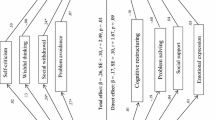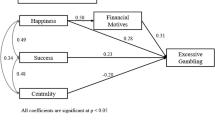Abstract
This study investigates the association of public, private and intrinsic religiosity and chance beliefs (superstition, illusion of control) with gambling behavior in a longitudinal follow-up study of younger and older adult subjects with DSM-IV pathological gambling (PG) and an older adult comparison group without PG. One-hundred sixty-three subjects were enrolled including 60 younger adults with PG (≥ 18/< 40 years), 53 older adults with PG (≥ 60 years), and 50 older adults without PG (≥ 60). Subjects were assessed at baseline and every 6 months thereafter. The Duke University Religion Index for Religious Assessment and the Drake Beliefs About Chance scales were administered at baseline. Follow-up was a mean (SD) of 2.6 (1.4) years. Older adults with PG scored lower on measures of public and intrinsic aspects of religiosity than older adults without PG, and scored higher on superstition and illusion of control. Older adults with PG also scored higher than younger adults with PG on private and intrinsic religiosity, but not public religiosity. Superstition predicted intrinsic, but not other aspects of religiosity. Importantly, during follow-up, higher levels of public and intrinsic religiosity were protective against problematic (levels 2, 3) gambling; were protective against chronic PG; and were predictive of PG remission status. Lower illusion of control ratings were protective against problematic gambling and chronic PG; lower superstition ratings were predictive of remission. We conclude that higher levels of public and intrinsic religiosity and lower levels of chance beliefs are associated with a more benign PG course.
Similar content being viewed by others
References
American Psychiatric Association. (1994). Diagnostic and statistical manual of mental disorders (4th ed.). Washington, DC: American Psychiatric Press.
American Psychiatric Association. (2013). Diagnostic and statistical manual of mental disorders (5th ed.). Arlington, VA: American Psychiatric Association.
Anonymous, Gamblers. (1984). Sharing recovery through gamblers anonymous. Los Angeles, CA: G.A. Publishing.
Barrault, S., & Varescon, I. (2013). Cognitive distortions, anxiety, and depression among regular and pathological gambling online poker players. Cyberpsychology, Behavior and Social Networking, 16(3), 183–188.
Beyerlein, K., & Sallaz, J. J. (2017). Faith’s wager: How religion deters gambling. Social Science Research, 62, 204–218.
Bischof, A., Meyer, C., Bischof, G., John, U., Wurst, F. M., Thon, N., et al. (2016). Type of gambling as an independent risk factor for suicidal events in pathological gamblers. Psychology of Addictive Behaviors, 30(2), 263–269.
Black, D. W., Coryell, W. H., Crowe, R. R., Shaw, M., McCormick, B., & Allen, J. (2015). Suicide ideation, suicide attempts, and completed suicide in persons with DSM-IV pathological gambling and their first-degree relatives. Suicide and Life Threatening Behaviors, 45(6), 700–709.
Black, D. W., Coryell, W., McCormick, B., Shaw, M., & Allen, J. (2017). A prospective follow-up study of younger and older subjects with pathological gambling. Psychiatry Research, 256, 162–168.
Black, D. W., & Grant, J. E. (2014). DSM-5 guidebook: The essential companion to the diagnostic and statistical manual of mental disorders (5th ed.). Washington, DC: American Psychiatric Publishing.
Casey, D. M., Williams, R. J., Mossière, A. M., Schopflocher, D. P., El-Guebaly, N., Hodgins, D. C., et al. (2011). The role of family, religiosity, and behavior in adolescent gambling. Journal of Adolescence, 34(5), 841–851.
Chan, V. K. (2012). The relationship between universal human values and adolescent problem and pathological gambling. Journal of Addictive Diseases, 31(2), 183–194.
Clark, L. (2014). Disordered gambling: The evolving concept of behavioral addiction. Annals of the New York Academy of Sciences, 1327, 46–61.
D’Agati, M. (2014). I feel like I’m going to win: Superstition in gambling. Qualitative Sociology Review, 10(2), 80–101.
Dennis, J. M. (2009). Summary of KnowledgePanel design. Knowledge Networsk, Palo Alto, CA. http://www.websm.org/db/12/13512/rec/ Accessed November 29, 2018.
Diaz, J. D. (2000). Religion and gambling in sin-city: A statistical analysis of the relationship between religion and gambling patterns in Las Vegas residents. The Social Science Journal, 37, 453–458.
Dowling, N. A., Merkouris, S. S., Greenwood, C. J., Oldenhof, E., Toumbourou, J. W., & Youssef, G. J. (2017). Early risk and protective factors for problem gambling: A systematic review and meta-analysis of longitudinal studies. Clinical Psychology Review, 51, 109–124.
Ghandour, L. A., & El Sayed, D. S. (2013). Gambling behaviors among university youth: Does one’s religious affiliation and level of religiosity play a role? Psychology Addictive Behaviors, 27(1), 279–286.
Harris, K. M., & Udry, J. R. (2018). National longitudinal study of adolescent to adult health (add health), 1994–2008. Ann Arbor, MI: Carolina Population Center, University of North Carolina-Chapel Hill [distributor], Inter-university Consortium for Political and Social Research. https://doi.org/10.3886/ICPSR21600.v21. Accessed November 29, 2018.
Hoffmann, J. P. (2000). Religion and problem gambling in the U.S. Review of Religious Research, 41(4), 488–509.
Kessler, R. C., Hwang, I., LaBrie, R., Petukhova, M., Sampson, N. A., Winters, K. C., et al. (2008). DSM-IV pathological gambling in the National Comorbidity Survey Replication. Psychological Medicine, 38(9), 1351–1360.
Koenig, H. G., & Bussing, A. (2010). The Duke University Religion Index (DUREL): A five-item measure for use in epidemiological studies. Religions, 1(1), 75–85.
Kramer, S. & Fahmy, D. (2018). Younger people are less religious than older ones in many countries, especially in the U.S. and Europe. Pew Research Center, June 13, 2018. http://www.pewresearch.org/fact-tank/2018. Accessed November 28, 2018.
Lader, M. (2008). Antiparkinsonian medication and pathological gambling. CNS Drugs, 22(5), 407–416.
Lam, D. (2006). The influence of religiosity on gambling participation. Journal of Gambling Studies, 22(3), 305–320.
Lesieur, H. R., & Blume, S. B. (1987). The South Oaks Gambling Screen (SOGS): A new instrument for the identification of pathological gamblers. American Journal of Psychiatry, 144(9), 1184–1188.
Lesieur, H. R., Cross, J., Frank, M., Welch, M., White, C. M., Rubenstein, G., et al. (1991). Gambling and pathological gambling among university students. Addictive Behaviors, 16(6), 517–527.
Mutti-Packer, S., Hodgins, D. C., Williams, R. J., & Konkolÿ Thege, B. (2017). The protective role of religiosity against problem gambling: Findings from a five-year prospective study. BMC Psychiatry, 17(1), 356.
National Opinion Research Center at the University of Chicago (NORC). (1999). Gambling impact and behavior study, report to the National Gambling Impact Study Commission.
Petry, N. M. (2005). Cognitive biases and cognitive therapy. In Pathological gambling: Etiology, comorbidity, and treatment (pp. 209–226). Washington DC: American Psychological Press.
Petry, N. M., Stinson, F. S., & Grant, B. F. (2005). Comorbidity of DSM-IV pathological gambling and other psychiatric disorders: Results from the National Epidemiologic Survey on Alcohol and Related Conditions. Journal of Clinical Psychiatry, 66(5), 564–574.
Rohrbaugh, J., & Jessor, R. (1975). Religiosity in youth: A personal control against deviant behavior. Journal of Personality, 43(157), 136–155.
Shaffer, H. J., & Hall, M. N. (1996). Estimating the prevalence of adolescent gambling disorders: A quantitative synthesis and guide toward standard gambling nomenclature. Journal of Gambling Studies, 12(2), 193–214.
Shaffer, H. J., & Korn, D. A. (2002). Gambling and related mental disorders: A public health analysis. Annual Review of Public Health, 23, 171–212.
Uecker, J. E., & Stokes, C. E. (2016). Religious background and gambling among young adults in the United States. Journal of Gambling Studies, 32(1), 341–361.
Warshaw, M. G., Keller, M. B., & Stout, R. L. (1994). Reliability and validity of the longitudinal interval follow-up evaluation for assessing outcome in anxiety disorders. Journal of Psychiatric Research, 28(6), 531–545.
Welte, J. W., Barnes, G. M., Tidwell, M. O., & Wieczorek, W. F. (2017). Predictors of problem gambling in the U.S. Journal of Gambling Studies, 33(2), 327–342.
Welte, J. W., Barnes, G. M., Wieczorek, W. F., Tidwell, M. C., & Parker, J. (2002). Gambling participation in the U.S.—Results from a national survey. Journal of Gambling Studies, 18(4), 313–337.
Welte, J. W., Barnes, G. M., Wieczorek, W. F., Tidwell, M. C., & Parker, J. C. (2004). Risk factors for pathological gambling. Addictive Behaviors, 29(2), 323–335.
Williams, R. J, Hann, R.G., Schopflocher, D. P., West, B. L., McLaughlin, P., White, N., et al. (2015). Quinte longitudinal study of gambling and problem gambling. Report prepared for the Ontario Problem Gambling Research Centre, Guelph, Ontario, Canada. http://hdl.handle.net/10133/3641. Accessed November 29, 2018.
Wohl, M. J. A., & Sztainert, T. (2011). Where did all the pathological gamblers go? Gambling symptomatology and stage of change predict attrition in longitudinal research. Journal of Gambling Studies, 27(1), 155–169.
Wood, W. S., & Clapham, M. M. (2005). Development of the drake beliefs about chance inventory. Journal of Gambling Studies, 21(4), 411–430.
Funding
The research was supported through a Grant from the National Institute on Aging (RO1AG037132).
Author information
Authors and Affiliations
Corresponding author
Ethics declarations
Conflict of interest
Dr. Black is a consultant to Otsuka and receives royalties from American Psychiatric Publishing, Oxford University Press, and UpToDate. Drs. Bormann and Allen, and Ms. Shaw report no conflicts.
Ethical Approval
All procedures performed in studies involving human participants were in accordance with the ethical standards of the University of Iowa Institutional Review Board and the 1964 Helsinki declaration and its later amendments or comparable ethical standards.
Additional information
Publisher's Note
Springer Nature remains neutral with regard to jurisdictional claims in published maps and institutional affiliations.
Rights and permissions
About this article
Cite this article
Bormann, N.L., Allen, J., Shaw, M. et al. Religiosity and Chance Beliefs in Persons with DSM-IV Pathological Gambling Enrolled in a Longitudinal Follow-Up Study. J Gambl Stud 35, 849–860 (2019). https://doi.org/10.1007/s10899-019-09857-w
Published:
Issue Date:
DOI: https://doi.org/10.1007/s10899-019-09857-w




